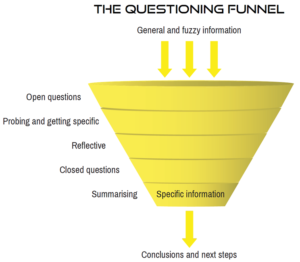In this interview, MatchFit’s Bradley Honnor talks with consultants Heather Rayfield and Nina Taylor about the process of designing a bespoke intervention for a client.
Firstly, what do we mean by interventions?
As Bradley explains, an intervention is the solution, together with the method of delivering the necessary skills and knowledge, in a response to a work-place challenge. This could entail a variety of strategies, from learning modules to one-to-one coaching, that together form a blended approach to effectively develop people and teams.
“It’s an intervention rather than a training program,” he says, “because it has a broader context and is delivered by us as a consultancy, rather than simply a learning and development organisation. For example, the requirement might involve HR professionals working with managers to develop their skills around how to run a disciplinary. But there might be dynamics in a team that aren’t really working and need to be resolved. So in this instance, we might create a training course as part of the solution, but also bring in an HR professional.
An intervention therefore closes the gaps, and brings together different elements to solve the client’s issues. We look at where the client is now, where they are moving from and to, and in that space lies the intervention.”
What are the steps to getting the information you need to start designing for the client?
“Initially we’d have a call with the client to discover what their thoughts are.” Nina explains. “But then we dig deeper with a full 360 Analysis. That would involve interviews with the senior people in the business such as CEOs or directors. It could involve employee interviews, and an employee survey, to understand what their thoughts are. We may have forums, where we undertake analysis and review the data to assess what needs fixing.”
“And what happens next is we listen,” Bradley says. ”Really, really listen. Because the client may not have the full picture yet, which is why the analysis is so important.”
“We start with a questioning funnel using open questions, which is really important because we’re aiming to learn ‘what’s on your mind?’.

People will then start to tell us things, (and there’s a whole process around that which I think is another conversation), but an important part of getting the solution right is getting the requirement right. While that’s not so difficult, there’s a level of sophistication and expertise needed to elicit that accurately. Very often, one individual doesn’t know what all of the requirement actually is, or has a view that not everybody shares. So we look at how to come to a collective consensus that fits everybody.”
Nina says “I would add ‘listen to understand’. Because, as well as asking probing questions, it’s about asking enough questions. So, the client might think it’s a surface problem, ‘oh, I just need to fix this problem,’ but the skill is in digging deeper to really understand what the problem is and what’s causing what they think is the issue.”
“And I would add one more thing” says Heather. “Obviously, it’s important to have robustness and rigour, but also to be flexible. Sometimes we find that we’ve done all our wonderful robustness and rigour and then after maybe the second session, new things emerge. It is about being observant and staying curious. The solution can invariably change, because change happens so quickly in an organisation that we have to be flexible and adaptable as part of that process as well.”
“I think it’s actually really good and healthy to say, ‘this will change, let’s not set it in stone,” says Bradley. “Because ultimately things will change as we go through the programmes and interventions. That’s been my experience – it never stays the same, ever.”
What other considerations do you come across?
“Time is often an issue,” says Bradley. “People are really busy, but it’s important for us to refine the requirement and complete the initial piece of work so that we can start the development and intervention delivery. But clients have their day jobs and priorities to manage. So encouraging people to carve out the time for what we need can be a challenge. And sometimes their expectation around the time needed to develop and then deliver a programme is unrealistic. Because it’s our professional world, we’re very aware of how tight time already is. But when people aren’t giving us what we need internally to get going, that can cause difficulties.”
How do you select the theories and methodologies that will suit the client, issue and desired solution?
“That’s a question for Heather,” says Bradley, “because she done some good work around this, and people have really enjoyed what she’s selected and delivered.”
“It is handy to have a background in learning development, as well as being a consultant,” Heather replies, “because there is a process, and having that core basic knowledge of what actually helps people make behavioural change is really important. That toolkit, plus lived experience and wisdom, is the foundation piece.
The next piece is using the analysis. Then we bring our lived experience and wisdom into the client’s world and find the sweet spot. Next we offer ideas based on considerations they’ve told us around time, budget, global reach, etc. Then, at the simplest level, we provide one to three options.”
“One thing I’d add to that, “says Nina, “is that we start with the end in mind. Once we know what we’re aiming for, that will inform our approach. So for instance, if you were a global company and it wasn’t possible to get everyone together, we might need to incorporate more e-learning, and videos. And we would have to think about the different elements and steps in the journey to decide which would deliver the best outcome.”
Bradley agrees: “Yes, and I’d reiterate the importance of having that background and experience. There are certain business models and concepts that just tend to work for the majority and resonate strongly for participants. More specifically, there are a number of models that I have experienced people’s reaction to many times around leadership, or change, or whatever the subject is. This is a great help too.”
“I’d say working in partnership with the client is also incredibly important,” says Heather. “So you’re not seen as some sort of bolt-on outsiders. It’s about working with them, engaging them every step of the process, so they understand the content and are living and breathing it, and they get a sense of what you’re doing.”
“They generally have other things going on in the business,” continued Bradley “and might already be applying a certain methodology. For example, at the moment I’m working with a company who are talking about ‘finding more zebras’. A zebra being your ideal client, because they look like a zebra. So if they were using that sort of terminology, that would probably influence how we come in off the back of that.”
What happens if an organisation is already applying a methodology, but you don’t think it will deliver the right outcome?
“That does come up!” says Bradley. “If a client is utilising something already, we can of course incorporate that if they want us to. We wouldn’t presume that we know better than the client about their own business. So we certainly incorporate what is being used but we will also bring new light to any given situation including new materials and insights.”
“We would also ask questions to understand their reasoning, and how we might add value to the broader solution,” adds Nina.
“We might ask them to tell us about some success they have had with it’,” adds Heather. “And then try to build on that success.”
How do MatchFit measure the effectiveness of the programme?
Bradley explains: “Measurement is essential for us at MatchFit, and we do it on four levels, five if the client allows:
- Reaction – How do people respond to what we’re doing? Are they finding it valuable? Are they enjoying it?
- Learning – What new insights are they gaining by taking part?
- Behaviour – What are they changing, what have they done differently based on those insights?
- Impact – Having done something differently, what is the result of that changed behaviour?
And then the fifth level, if they can share the information, is ‘What is the monetary value of that change? What has actually been saved, or made financially?
For example, one client has saved over £120,000 pounds on average for each unit the intervention was rolled out in, because the leadership really engaged in the programmes and learned not only that it was important to manage things differently, but how to do so.
We’ve earned so much credibility with clients by being able to measure outcomes. There’s a lot of learning and development that people go on that isn’t measured at all, and I honestly believe that’s a waste of budget.”
What is MatchFit’s top tips for designing a really great programme?
- You don’t get a degree in one day. So invest in programmes not training days.
- Support people in committing the time for their development.
- Make sure your consultant communicates well, is open to different ideas and asks sufficient questions to really understand the problem. Are they really listening?
- The best interventions have reflection time built in. People are so busy, and have such a lot going on, they need to have time to sit quietly with the content and look at it to build results.
- Does the programme include wellbeing support? Learning and doing new things creates stress (positive stress) in the body, so wellness support woven in helps people bring their very best self all the way through.
- Does the programme have plenty of interaction? Does it get people involved in what they are learning so that they can practice the skills?
- How will it be measured?
Bradley concludes, “It’s really important to MatchFit that we work in partnership with a client and get to know the senior team, because we’re there to facilitate positive change. We’re not just flying in and flying out to supply a service. We need to engage the senior leadership team, because even if they’re not coming on the intervention, they need to be aware of what the intervention involves. When we step away, they’re the people who are going to continue embedding those new skills and behaviours. That’s how we set them up for success.”
To learn more about the MatchFit CLIMB interventions, please visit the website https://matchfitwith.com/climb-interventions/
If you’d like to learn more about our MatchFit programmes, take a look at our information pages here, or why not get in touch? [email protected] or call +44 (0) 7858 775 249

